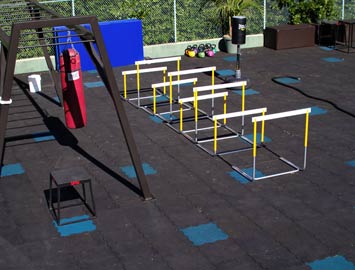 The recent growth of the recycled rubber industry has caused a surge in the popularity of premium gym flooring. Nowadays, almost every public gym has installed comfortable and durable rubber mats in workout room floors. However, this was not always the case! The introduction of rubber fitness mats is a relatively recent development in fitness flooring standards, following a long history of other protective fitness surfaces.
The recent growth of the recycled rubber industry has caused a surge in the popularity of premium gym flooring. Nowadays, almost every public gym has installed comfortable and durable rubber mats in workout room floors. However, this was not always the case! The introduction of rubber fitness mats is a relatively recent development in fitness flooring standards, following a long history of other protective fitness surfaces.
Gymnasiums themselves have actually been around for years, dating back to Ancient Greece. The first recorded use of the word gymnasium comes from the Greek meaning, “place to be naked.” This is because the first gymnasiums were used for the education of young men—mainly in physical education, which was performed naked at the time. Simple fitness mats may have been woven from fabrics to provide traction in post-exercise bathing areas, but that is the closest that the Greeks got to any sort of gym flooring. The Greeks adoration for the human body and proper form is apparent in statues constructed at the time. Gymnasiums were a place to cultivate the body as well as the mind, hence the gymnasium was a place to broaden one’s intellectual and physical education.
 A few centuries later in Germany, gymnasiums had evolved to mean “places for gymnastics.” German educator Friedrich Jahn and the Turners invented what was called the Turnplatz, a designated area for outdoor gymnastic exercises. Friedrich Jahn, whose personal motto was “a sound mind in a sound body”, promoted both physical exercise and intellectual development, a borrowed concept perhaps from the Greeks. His motto lives on in his inventions: the parallel bars, rings, horse, and horizontal bar are all Jahn’s inventions, and are still used in gymnastics today. Athletes using his innovative equipment needed a soft padding, and as a result, sand pits and hay were used in addition to the hard ground required for landing areas. These surfaces were considered to be the forefathers of today’s fitness mats. Though they were made from everyday materials, it was the fact that they were used solely for the purpose of cushioning and protection. Although this fitness flooring should be considered the forefather of gymnastic mats, the concept of spending resources on floor protection and an athlete’s safety runs parallel to modern times.
A few centuries later in Germany, gymnasiums had evolved to mean “places for gymnastics.” German educator Friedrich Jahn and the Turners invented what was called the Turnplatz, a designated area for outdoor gymnastic exercises. Friedrich Jahn, whose personal motto was “a sound mind in a sound body”, promoted both physical exercise and intellectual development, a borrowed concept perhaps from the Greeks. His motto lives on in his inventions: the parallel bars, rings, horse, and horizontal bar are all Jahn’s inventions, and are still used in gymnastics today. Athletes using his innovative equipment needed a soft padding, and as a result, sand pits and hay were used in addition to the hard ground required for landing areas. These surfaces were considered to be the forefathers of today’s fitness mats. Though they were made from everyday materials, it was the fact that they were used solely for the purpose of cushioning and protection. Although this fitness flooring should be considered the forefather of gymnastic mats, the concept of spending resources on floor protection and an athlete’s safety runs parallel to modern times.
Inspired by the Turner movement, public gymnasiums sprung up in the US in the early 1800’s. Eventually, gyms made their way into schools and colleges, and even became large independent organizations, like the YMCA. Gym mat technology was beginning to gain momentum, and soon earthy materials were replaced by soft surfaces like cotton stuffed pads and mattresses. Different types of fitness flooring were beginning to emerge, based on specific gymnastic activities. Crash, tumble, and landing mats were utilized in high impact areas, while hard surfaces were still prominent in areas that required solid ground, like weight lifting rooms. Needless to mention the weight equipment of this era needed protection from the hard floors and vice versa!
Before the development of rubber synthetics, it was difficult to obtain large amounts of rubber at a cost effective price. High costs associated with producing and installing rubber floors kept it quite out of reach until very recently. Now, with a ready availability of recycled and reclaimed rubber on the market, as well as new technology for rubber synthetics, it has become much more accessible. The cost of recycled rubber production resides in the process rather than the materials. The recycling of the rubber tire, shredding and removal of other contents is one part of the cost formula. As is the production of Tire Derived Products such as rubber floor tiles or rubber playground surfacing the second leg of the costs. The availability of huge stockpiles of used tires has led most American States to subsidize the recycling of the tire. Essentially the tire rubber costs reside in the processes that make it friendly to production. The level of safety that rubber offers to athletes is unparalleled, making it ideal for gym floors— rubber fitness mats are hard and sturdy, yet provide enough soft cushion to protect muscles and joints. This combination of long life, affordability, and comfort is hard to find in other material. Carpet floors, plastics, wood and composites all lack at least one of the dimensions noted above and cannot compete with rubber fitness flooring!